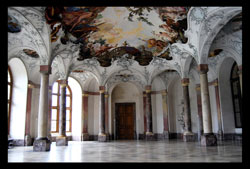|
Munich houses the largest palace in Germany, a city-castle that also served as the seat of government of Bavaria (now Germany). After centuries of use by kings, emperors, and dukes, the series of buildings is now open for the public to view. With Renaissance-era statues, Baroque-influenced décor, and breathtaking paintings, the Residenz is definitely worth a trip.
A Palace for Royalty
The Residenz was a building created for a function as well as for style. The Bavarian dukes, kings, and electors treated the palace as a seat of government until as late as 1918. What began as a small castle in 1385 expanded and grew over the years. Today, its more than 130 rooms are full of the artworks, furnishings, and stately appearance that it had many years ago. Over the more than four-hundred-year history as serving as a seat of government, the palace adopted the styles of many periods from Baroque to Neo-Classicism to late Renaissance. Today, visitors can view the collections and treasury of the royalty and kings of Bavaria.
A German Treasure Trove: The Antiquarium
The palace is huge, with several expansive court rooms, a lush garden, a gorgeous red-and-gold theater, and a court church. However, one of the most famous rooms is the breathtaking Antiquarium, or Hall of Antiquities. Duke Albrecht V initially created the huge room to simply house his collection of antiques. His successors, including his son Maximilian I, lowered the floor, introduced the amazing ceiling paintings and grotesques, and changed the function of the room from a place to house antiques to a grand banquet and festival hall. Several painters, including Peter Candid, adorned the hall with their gorgeous works in the early 1570s. The Antiquarium happens to be the largest hall from the Renaissance north of the Alps, at 66 meters long (about 216 feet).
|
|




